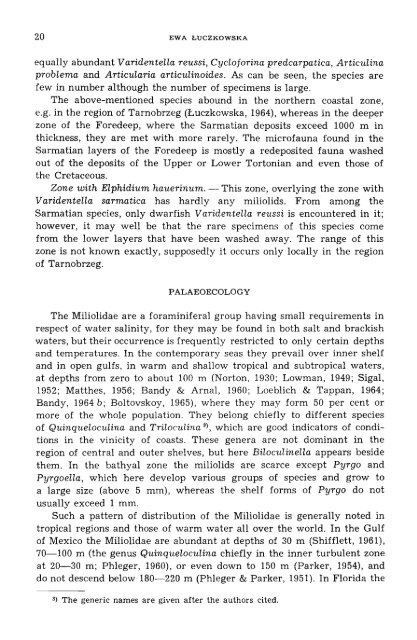MILIOLIDAE - Acta Palaeontologica Polonica
MILIOLIDAE - Acta Palaeontologica Polonica
MILIOLIDAE - Acta Palaeontologica Polonica
Create successful ePaper yourself
Turn your PDF publications into a flip-book with our unique Google optimized e-Paper software.
20 EWA LUCZKOWSKA<br />
equally abundant Varidentella reussi, Cycloforina predcarpatica, Articulina<br />
problema and Articularia articulinoides. As can be seen, the species are<br />
few in number although the number of specimens is large.<br />
The above-mentioned species abound in the northern coastal zone,<br />
e.g. in the region of Tarnobrzeg (Luczkowska, 1964), whereas in the deeper<br />
zone of the Foredeep, where the Sarmatian deposits exceed 1000 m in<br />
thickness, they are met with more rarely. The microfauna found in the<br />
Sarmatian layers of the Foredeep is mostly a redeposited fauna washed<br />
out of the deposits of the Upper or Lower Tortonian and even those of<br />
the Cretaceous.<br />
Zone with Elphidium hauerinum. - This zone, overlying the zone with<br />
Varidentella sarmatica has hardly any miliolids. From among the<br />
Sarmatian species, only dwarfish Varidentella reussi is encountered in it;<br />
however, it may well be that the rare specimens of this species come<br />
from the lower layers that have been washed away. The range of this<br />
zone is not known exactly, supposedly it occurs only locally in the region<br />
of Tarnobrzeg.<br />
PALAEOECOLOGY<br />
The Miliolidae are a foraminiferal group having small requirements in<br />
respect of water salinity, for they may be found in both salt and brackish<br />
waters, but their occurrence is frequently restricted to only certain depths<br />
and temperatures. In the contemporary seas they prevail over inner shelf<br />
and in open gulfs, in warm and shallow tropical and subtropical waters,<br />
at depths from zero to about 100 m (Norton, 1930; Lowman, 1949; Sigal,<br />
1952; Matthes, 1956; Bandy & Arnal, 1960; Loeblich & Tappan, 1964;<br />
Bandy, 1964 b; Boltovskoy, 1965), where they may form 50 per cent or<br />
more of the whole population. They belong chiefly to different species<br />
of Quinqueloculina and Triloculina 3), which are good indicators of conditions<br />
in the vinicity of coasts. These genera are not dominant in the<br />
region of central and outer shelves, but here Biloculinella appears beside<br />
them. In the bathyal zone the miliolids are scarce except Pyrgo and<br />
Pyrgoella, which here develop various groups of species and grow to<br />
a large size (above 5 mm), whereas the shelf forms of Pyrgo do not<br />
usually exceed 1 mm.<br />
Such a pattern of distribution of the Miliolidae is generally noted in<br />
tropical regions and those of warm water all over the world. In the Gulf<br />
of Mexico the Miliolidae are abundant at depths of 30 m (Shifflett, 1961),<br />
70-100 m (the genus Quinqueloculina chiefly in the inner turbulent zone<br />
at 20-30 m; Phleger, 1960), or even down to 150 m (Parker, 1954), and<br />
do not descend below 180-220 m (Phleger & Parker, 1951). In Florida the<br />
3) The generic names are given after the authors cited.
















